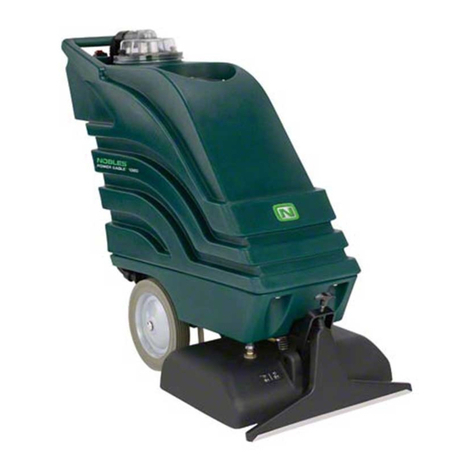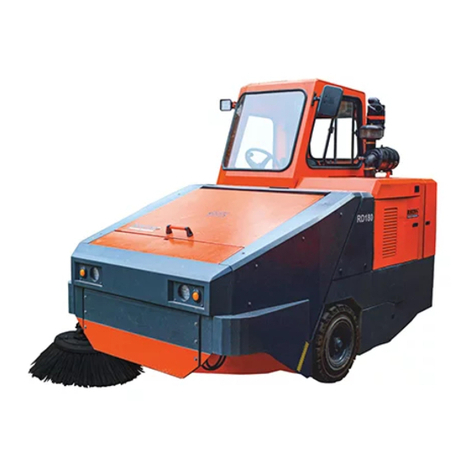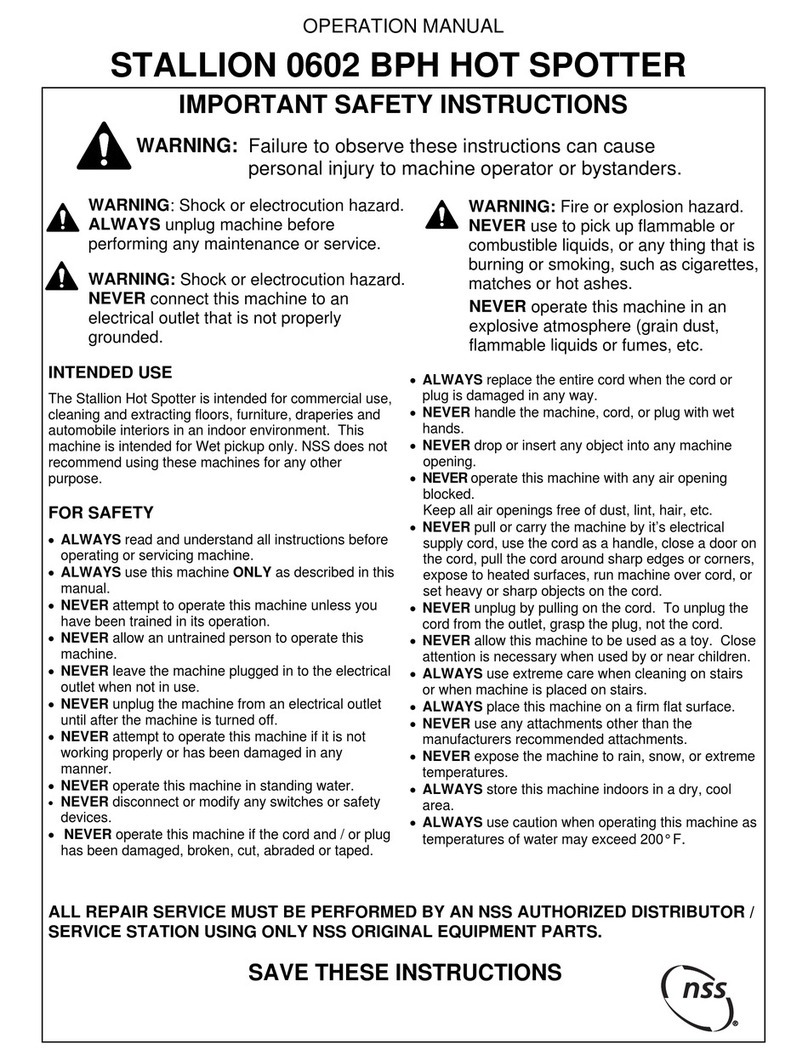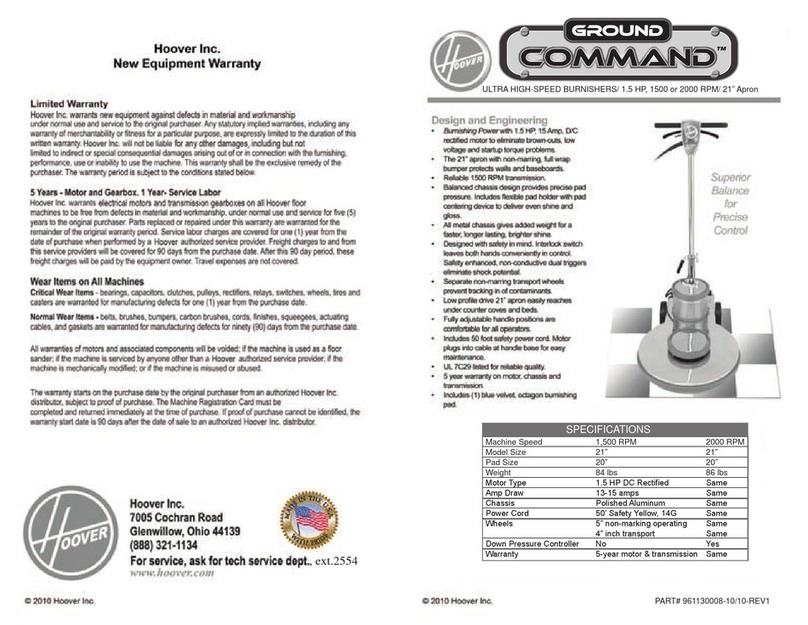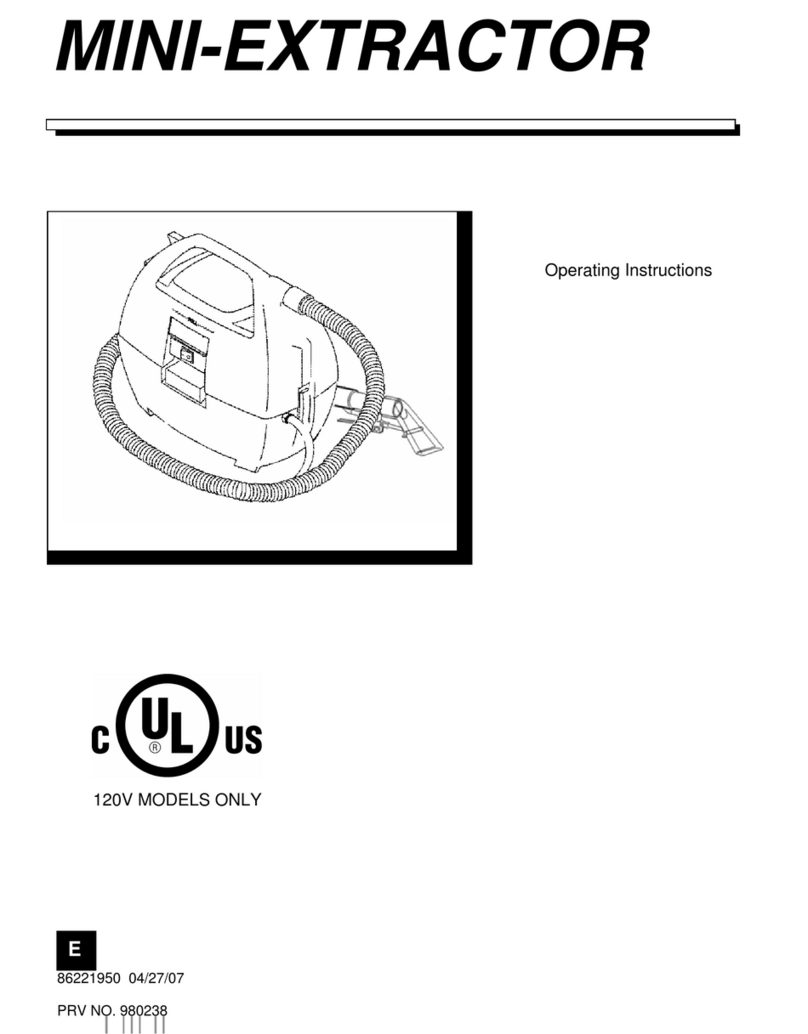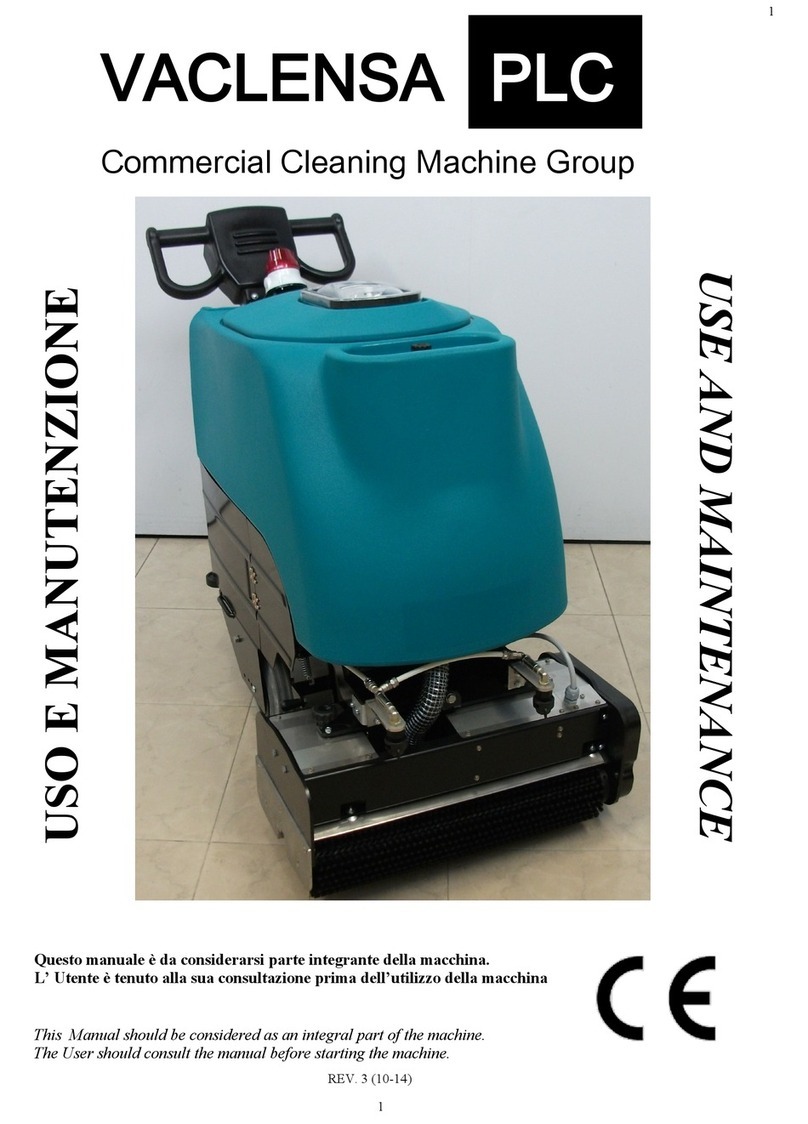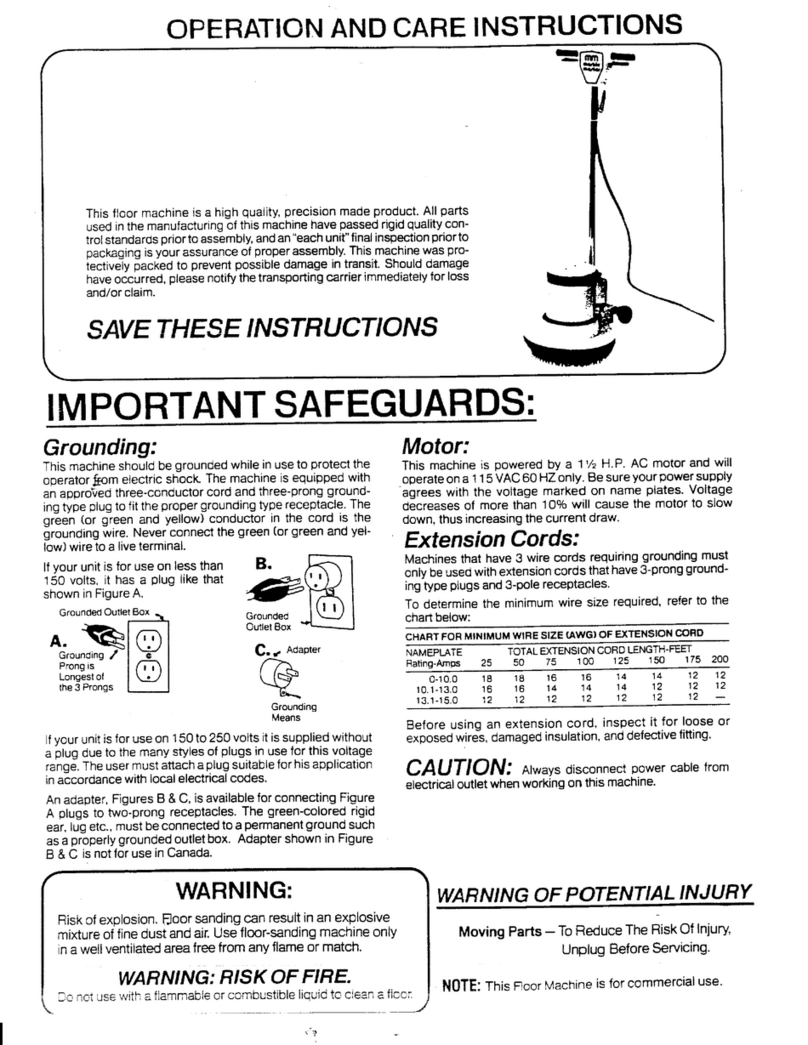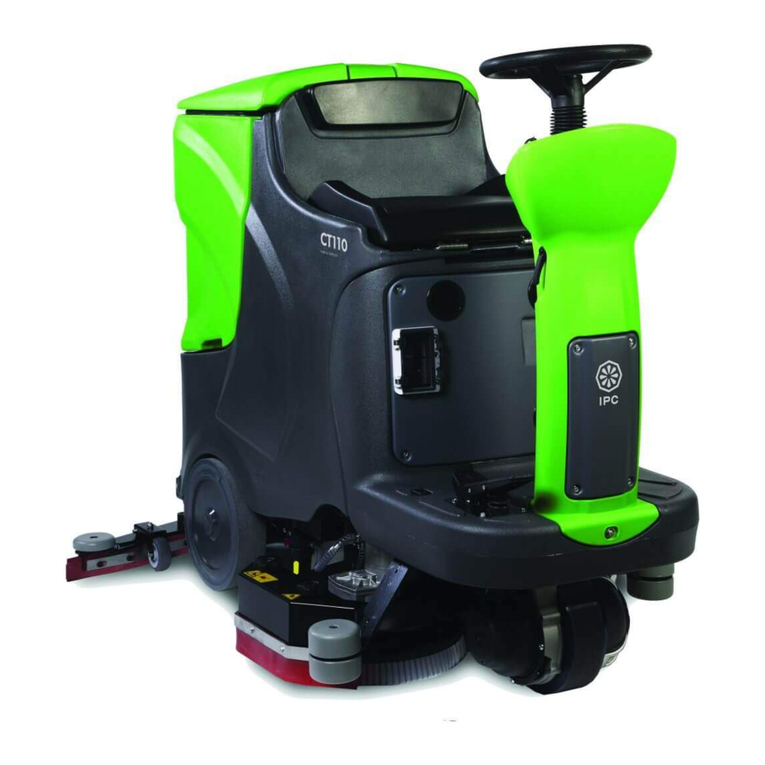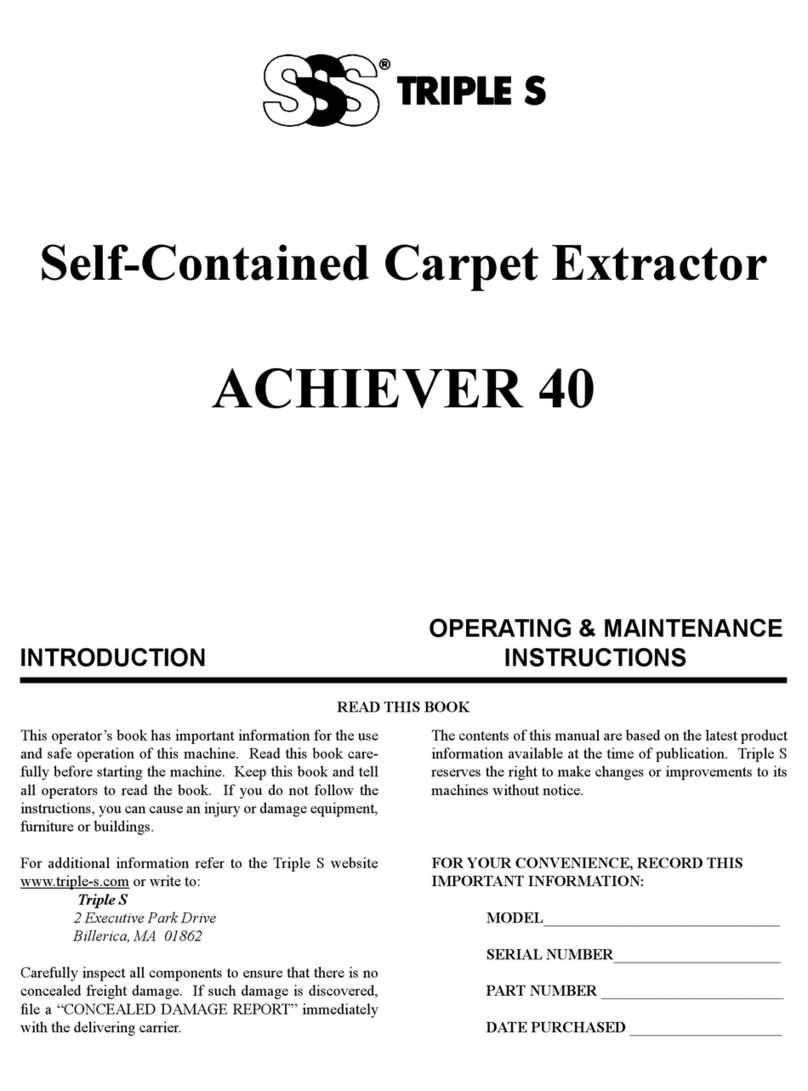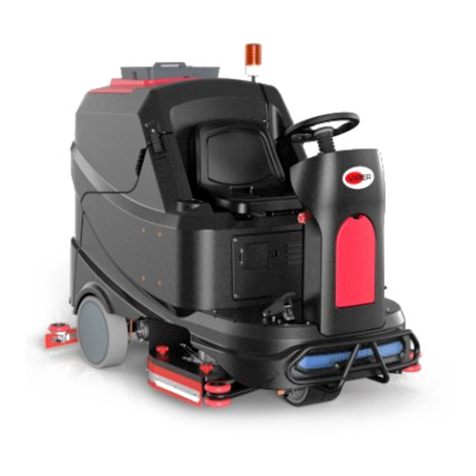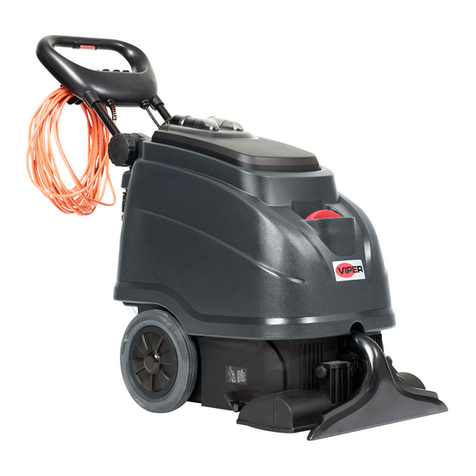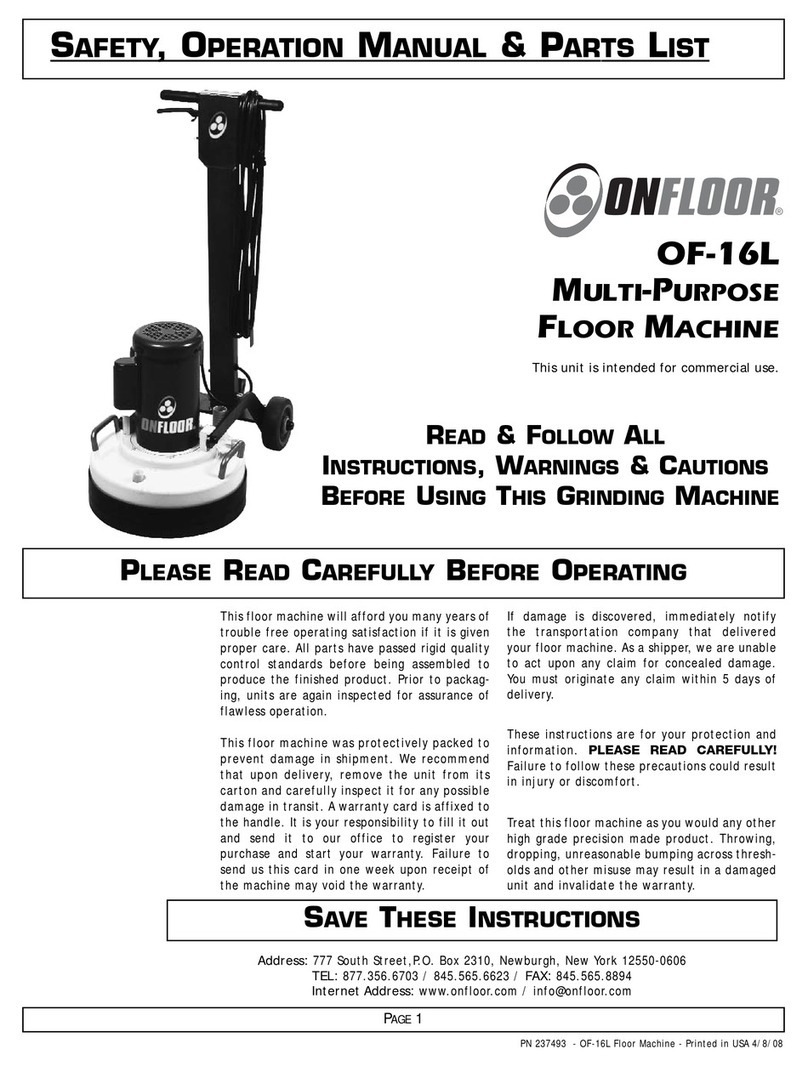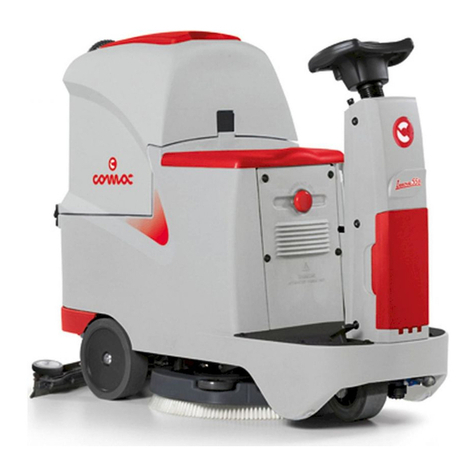Topfloor TF155R-GTX Series User manual

TF155R-GTX
www.crescentindustrial.co.uk/TOPFLOOR
Troubleshooting
Guide
Italian
English


2010-12 3/ 4
Grazie per aver scelto una spazzatrice
Abbiamo studiato questo manuale espressamente per permetterle di apprezzare completamente le doti
tecniche e la ricerca di stile della sua nuova macchina.
Nelle pagine seguenti sono contenute le indicazioni rivolte all’uso corretto ed alla manutenzione non-
ché i consigli e le avvertenze per un uso pratico e sicuro della macchina.
Thank you for having choosing our sweeper
This manual was expressly conceived to allow you to fully appreciate the technical advantages and the
stylistic research of your new machine.
The following pages contain indications concerning its correct use and maintenance, as well as
suggestions and warnings for its practical and safe use.

2010-12
4/ 4
- 1 -
Ed. 2011-03
- 2 -
Ed. 2010-12
- 3 -
Ed. 2010-12
- 4 -
Ed. 2010-12
- 5 -
Ed. 2010-12
- 6 -
Ed. 2010-12
INDICE DEI CAPITOLI
CAPITOLO /
INTRODUZIONE - AVVERTENZE /
(Introduzione - Avvertenze generali - Norme costruttive e marcatura CE - Consegna della macchina - Uso
previsto della macchina - Uso non previsto della macchina - Limitazioni d’impiego - Controlli - Norme di
sicurezza - Norme per la manutenzione - Norme per gli incendi - Demolizione della macchina e smaltimento
sostanze nocive)
CAPITOLO /
SICUREZZE - MOVIMENTAZIONE /
(Targhette di avvertenze - Dispositivi di sicurezza - Zone a rischio residuo - Movimentazione e trasporto)
CAPITOLO /
DATI TECNICI - IDENTIFICAZIONE /
(Dimensioni di ingombro - Dati tecnici - Emissione sonora della macchina - Informazioni sulle vibrazioni
-Identificazione della macchina)
CAPITOLO /
CONOSCENZA /
(Accessibilità organi interni - Viste generali - Strumentazione e comandi - Regolazioni)
CAPITOLO /
USO /
(Controlli preliminari - Avviamento della macchina - Trasferimento - Lavoro di pulizia - Carica batteria EH
- Messa fuori servizio)
CAPITOLO /
MANUTENZIONE /
(Operazioni di manutenzione - Manutenzione secondo necessità - Manutenzione programmata - Manuten-
zione giornaliera - Manutenzione settimanale - Manutenzione periodica - Tabella rifornimenti)
NOTA:
Per gli schemi della macchina (elettrici, idraulici, idrici, ecc...) rivolgersi al servizio di assistenza tecnica
CHAPTERS INDEX
CHAPTER
INTRODUCTION - WARNINGS
(Introduction - General warnings - Constructional regulations and EC marking - Machine delivery - Expected use
of the machine - Unexpected use of the machine - Use restrictions - Checks - Safety rules - Maintenance instruc-
tions - Fire standards - Machine demolition and disposal of noxious substances)
CHAPTER
SAFETY DEVICES - HANDLING
(Warning plates - Safety devices - Residual risk areas - Handling and transport)
CHAPTER
TECHNICAL DATA - IDENTIFICATION
(Overall dimensions - Technical data - Machine noise emission - Information about vibrations - Identification of
the machine)
CHAPTER
KNOWLEDGE
(Access to internal parts - Overall views - Instrumentation and controls - Adjustments)
CHAPTER
USE
(Preliminary checks - Machine start - Transferral - Sweeping operations - Battery charge EH - Putting the machine
out of service)
CHAPTER
MAINTENANCE
(Maintenance operations - Extraordinary maintenance - Routine maintenance - Daily maintenance - Weekly main-
tenance - Periodical maintenance - Refuelling table)
NOTE:
atic (electrical, hydraulic, water supply, etc...)

2011-03 1/ 18
-1-
INTRODUZIONE - AVVERTENZE
1.1 - INTRODUZIONE.................................................................................................... 3
1.1.a - Scopo del manuale ..................................................................................... 3
1.1.b -Consultazione del manuale......................................................................... 3
1.1.c -Legenda simboli ......................................................................................... 3
1.1.d - Terminologia usata nel manuale.................................................................. 4
1.2 - AVVERTENZE GENERALI..................................................................................... 4
1.2.a -Avvertenze per operatori ............................................................................. 4
1.2.b - Posizione dell’operatore ............................................................................. 4
1.2.c -Responsabilita’ del costruttore.................................................................... 4
1.2.d - Assistenza tecnica ..................................................................................... 5
1.2.e - Parti di ricambio ......................................................................................... 5
1.3 - NORME COSTRUTTIVE E MARCATURA CE........................................................ 6
1.4 - CONSEGNA DELLA MACCHINA........................................................................... 6
1.5 - USO PREVISTO DELLA MACCHINA.................................................................... 6
1.6 - USO NON PREVISTO DELLA MACCHINA........................................................... 7
1.6.a - Zone con rischio di esplosione.................................................................... 7
1.6.b- Trasporto - traino ........................................................................................ 7
1.7 - LIMITAZIONI D’IMPIEGO...................................................................................... 7
1.7.a - Emissioni gassose dei motori a combustione interna ................................. 8
1.8 - CONTROLLI.......................................................................................................... 8
INTRODUCTION - WARNINGS
INDICE - INDEX
Capitolo 1Chapter
1.1 - INTRODUCTION
1.1.a - Purpose of the manual
1.1.b -Reading the manual
1.1.c - Legend of the symbols
1.1.d - Terminology used in the manual
1.2 - GENERAL WARNINGS
1.2.a - Operators’instructions
1.2.b - Operator’s position
1.2.c -Manufacturer’s responsibility
1.2.d - Servicing
1.2.e - Spare parts
1.3 - CONSTRUCTIONAL REGULATIONS AND EC MARKING
1.4 - MACHINE DELIVERY
1.5 - EXPECTED USE OF THE MACHINE
1.6 - UNEXPECTED USE OF THE MACHINE
1.6.a - Areas with explosion hazard
1.6.b - Transportation - towing
1.7 - USE RESTRICTIONS
1.7.a - Gas emission of internal combustion engines
1.8 - CHECKS

2011-03
2/ 18
- 1 -
1.9 - NORME DI SICUREZZA......................................................................................... 9
1.9.a - Personale autorizzato................................................................................. 9
1.9.b - Abbigliamento antinfortunistico ed equipaggiamento di protezione personale ... 9
1.9.c -Avvertenze generali....................................................................................10
1.9.d - Prima dell’avviamento ................................................................................ 11
1.9.e -Durante l’impiego....................................................................................... 11
1.9.f -Scarico del contenitore ..............................................................................12
1.9.g - Fermo macchina .......................................................................................12
1.9.h - Norme di sicurezza relative ai materiali di esercizio ................................... 13
1.9.i -Norme di sicurezza generali per gas liquido ...............................................13
1.9.l - Norme di sicurezza generali per l’installazione/sostituzone della
bombola ....................................................................................................14
1.9.m -Norme di sicurezza generali per il controllo e la verifica dell’impianto
a gpl ..........................................................................................................15
1.9.n - Norme per l’utilizzo di macchine con alimentazione a gas gpl ................... 16
1.9.o - Comportamento in caso di emergenza ......................................................16
1.10 - NORME PER LA MANUTENZIONE..................................................................... 17
1.11 - NORME PER GLI INCENDI.................................................................................18
1.12 - DEMOLIZIONE DELLA MACCHINA E SMALTIMENTO SOSTANZE NOCIVE.....18
INDICE - INDEX
1.9 - SAFETY RULES
1.9.a - Authorized people
1.9.b - Accident prevention clothing and personal protective equipment
1.9.c - General warnings
1.9.d - Before starting
1.9.e -During use
1.9.f -Dumping the waste container
1.9.g -Machine stop
1.9.h - Safety instructions for supplies
1.9.i - General safety rules for liquid gas
1.9.l - General safety rules for bottle
installation/replacement
1.9.m - General safety rules for LPG
systems checks
1.9.n - Rules for the use of LPG machines
1.9.o - Behavior in case of an emergency
1.10 - MAINTENANCE INSTRUCTIONS
1.11 - FIRE STANDARDS
1.12 - MACHINE DEMOLITION AND DISPOSAL OF NOXIOUS SUBSTANCES

2011-03 3/ 18
-1-
1.1 - INTRODUZIONE
Il presente manuale è stato redatto dal costruttore e
costituisce parte integrante della macchina stessa; deve
pertanto essere conservato con cura e per tutta la vita
della macchina fino alla demolizione in un luogo sicuro
ed accessibile a tutti gli utilizzatori (operatori e persona-
le addetto alla manutenzione).
Nel caso di vendita della macchina, assicurarsi di conse-
gnare al nuovo acquirente il presente manuale e tutta la
documentazione tecnica allegata.
Eventuali copie del manuale e della documentazione
fornita a corredo possono essere richieste al costruttore
specificando il tipo ed il numero di matricola della mac-
china.
1.1.a - SCOPO DEL MANUALE
Scopo del manuale è di fornire le istruzioni necessarie
per la messa in servizio, l’uso e la manutenzione della
macchina alla quale sono riferite.
Una attenta lettura delle istruzioni e la scrupolosa osser-
vanza delle norme di sicurezza fornite nel manuale
garantiscono di ottenere i migliori risultati in termini di
prestazioni, sicurezza operativa, efficacia, economia di
esercizio e durata nel tempo della macchina.
La mancata osservanza di tali istruzioni potrebbe causa-
re danni alla macchina, all’uomo ed all’ambiente che in
nessun caso potranno essere imputati al costruttore.
Le indicazioni e le istruzioni fornite nel manuale non
intendono comunque sostituire, integrare o modificare
qualsiasiNORMA,PRESCRIZIONE, DECRETO o LEG-
GE di carattere generale o specifico in vigore nel luogo
in cui opera la macchina e riguardanti la sicurezza, l’uso
e la manutenzione di apparecchiature o dispositivi mec-
canici, elettrici, chimici, oleodinamici, pneumatici o altro.
1.1.b - CONSULTAZIONE DEL MANUALE
Il manuale è suddiviso in capitoli secondo un ordine
logico di conoscenza ed impiego della macchina.
Per facilitare la ricerca degli argomenti di interesse,
consultare prima l’INDICE DEI CAPITOLI riportato al-
l’inizio del manuale e quindi ricercare le specifiche
informazioni nell’indice del capitolo individuato.
1.1.c - LEGENDA SIMBOLI
Per evidenziare informazioni e procedure relative alla
sicurezza di impiego, manutenzione, ecc..., nel manua-
le sono stati adottati i seguenti simboli:
ATTENZIONE PERICOLO:
Avvertimento dell’esistenza di seri pericoli per
l’incolumità fisica o danni per la salute dell’operato-
re e/o terze persone.
Osservare scrupolosamente le precauzioni elenca-
te.
1.1 - INTRODUCTION
This manual has been prepared by the manufacturer
and constitutes an integral part of the vehicle; it must
therefore be kept with care and in a safe place easily
accessible to all users (operators and service person-
nel) for the vehicle’s entire life time up to its demolition.
If the vehicle should be sold, make sure to give this
manual, as well as all the enclosed technical documents,
to the new owner.
Copies of this manual and of the documents accompa-
nying the vehicle may be requested to the manufacturer
by specifying the type of vehicle and its serial number.
1.1.a - PURPOSE OF THE MANUAL
The purpose of this manual is to provide all the instruc-
tions necessary for the vehicle’s operation, use and
maintenance.
By carefully reading the instructions and by scrupulously
observing the safety rules contained herein it is possible
to obtain the best possible results in terms of perfor-
mance, safety, efficiency, operational management and
duration of the vehicle.
Non-observance of such instructions could cause damage
or harm to the vehicle, to people and to the environment
which cannot, in any case, be blamed on the manufacturer.
The indications and instructions of this manual are not
meant to substitute, integrate or modify any REGULA-
TION, DIRECTIVE, DECREE or LAW of a general or a
specific nature in force in the country where the machine
is to operate regarding safety, use and maintenance of
mechanical, electric, chemical, oil-pressure, pneumatic
or other types of devices.
1.1.b - READING THE MANUAL
The manual is subdivided in chapters according to a
logical sequence of knowledge and use of the machine.
To easily search for the topics of interest, first look at the
CHAPTER SUMMARY at the beginning of this manual
and then look for the specific information in the summary
of the identified chapter.
1.1.c - LEGEND OF THE SYMBOLS
To emphasize information and procedures regarding
safety of use, maintenance, etc... the following symbols
are used throughout the manual:
WARNING DANGER:
It indicates that a serious danger exists for the
operator’sorotherpeople’spersonal safetyor health.
Scrupulously observe the indicated precautions.

2011-03
4/ 18
- 1 -
AVVERTENZA:
Informazioni di estrema importanza atte ad evitare
seri danni alla macchina ed all’ambiente in cui
opera.
NOTA:
Informazioni aggiuntive per il corretto funziona-
mento della macchina o di carattere generale.
1.1.d - TERMINOLOGIAUSATANELMANUALE
Nel manuale è stata adottata la seguente terminologia:
Il termine Macchina viene utilizzato in sostituzione della
denominazione commercialea cui il presente manualesi
riferisce.
Iterminianteriore,posteriore,destro,sinistro,inferio-
re,superiore sono riferiti alla macchina vista dall’opera-
tore al posto di guida.
Il termine OPT (opzionale) identifica gli accessori
installabiliarichiestae pertantononsemprepresentisulla
macchina.
1.2 - AVVERTENZE GENERALI
1.2.a - AVVERTENZEPEROPERATORI
Prima della messa in servizio, dell’uso e della manuten-
zione della macchina è necessario che gli operatori e i
manutentori della medesima siano a conoscenza delle
procedure operative, delle prescrizioni e delle norme di
sicurezzariportatenelpresentemanualeenellaeventuale
documentazioneallegatarelativaamotore,batterie,ecc...
e che abbiano compiuto un addestramento pratico sulla
macchina.
1.2.b - POSIZIONE DELL’OPERATORE
L’operatore, durante il lavoro è seduto al posto di guida o
opera attorno alla macchina solo quando usa l’aspirafoglie
manuale (OPT).
1.2.c - RESPONSABILITA’ DEL COSTRUTTORE
Il costruttore, TOPFLOOR, non si riterrà responsabile di
inconvenienti, rotture, incidenti ecc..., dovuti alla non co-
noscenza (o comunque alla non applicazione) delle avv-
ertenze e istruzioni contenute nel presente manuale.Lo
stesso dicasi per qualsiasi uso non coretto, abuso, o per
l’esecuzione di modifiche, varianti e/o l’installazione di
accessori non autorizzati preventivamente per iscritto da
TOPFLOOR. Fare riferimento alla garanzia TOPFLOOR.
WARNING:
Very important information to avoid serious damage
to the machine and to the environment in which it
works.
NOTE:
Additional information for proper machine opera-
tion or of a general nature.
1.1.d - TERMINOLOGY USED IN THE MANUAL
The following terminology has been used in this manual:
The term Machine is used instead of the commercial
name to which this manual refers.
The terms front,back,right,left,lower,upper refer to
the machine as seen by the operator sitting on the driver’s
seat.
The term OPT (optional) indicates the accessories that
may be applied on request and which are therefore not
always present on the machine.
1.2 - GENERAL WARNINGS
1.2.a - OPERATORS’INSTRUCTIONS
Before operating, using or servicing the vehicle, its
operators and service personnel must be knowledgeable
about the operating procedures, directions and safety
standards listed in the present manual and in the other
enclosed documents relative to engine, batteries, etc...
Furthermore, they must have been practically trained to
operate the vehicle.
1.2.b - OPERATOR’S POSITION
When the operator is working, he is seated on the driver’s
seat or operates around the machine only when he’s using
the manual leaf-suction hose (OPT).
1.2.c - MANUFACTURER’S RESPONSIBILITY
The manufacturer, TOPFLOOR, declines any respon-
sibility arising from breaks, accidents, etc... due to the
lack of knowledge (or to the lack of application)of the
warnings and instructions contained in this manual,or
for any misuse, abuse or for any change, variation
and/or installation of accessories that has not been
previously authorized in writing by TOPFLOOR.
Please see TOPFLOOR warranty.

2011-03 5/ 18
-1-
In particolare TOPFLOOR declina ogni responsabilità
per danni derivanti da:
- Calamità naturali
- Manovre errate
- Mancanza di manutenzione
Il costruttore non risponde dei danni di qualsiasi tipo (a
persone, animali, cose e alla macchina) causati da inter-
venti sulla macchina (per manutenzione, riparazioni,
ecc...) se detti interventi non sono stati eseguiti da PER-
SONALEAUTORIZZATO TOPFLOOR (salvo accordi
diversi autorizzati da TOPFLOOR).
1.2.d - ASSISTENZA TECNICA
Il costruttore mette al servizio della clientela il proprio
ServizioAssistenza Tecnica per risolvere qualunque pro-
blema riguardante l’impiego e la manutenzione della mac-
china. Le eventuali richieste di intervento tecnico devono
essere fatte dopo una attenta analisi degli inconvenienti
e delle loro cause.
Nel caso di richieste scritte si prega di specificare nel
messaggio quanto segue:
-Modello macchina
-Numero matricola
- Il dettaglio dei difetti riscontrati
- I controlli eseguiti
- Le regolazioni effettuate ed i loro effetti
- Ogni altra informazione ritenuta utile
Indirizzare le richieste a:
CRESCENT INDUSTRIAL S.p.A.
Berrington House,
Berrington Road,
Leamington Spa CV31 1NB
Tel. +
Fax +
info@c-ind.co.uk
oppure alla "RETE DI ASSISTENZAAUTORIZZATA"
1.2.e - PARTI DI RICAMBIO
Utilizzare esclusivamente RICAMBI ORIGINALI forniti
dal costruttore. L’utilizzo di ricambi non originali fa deca-
derela garanziae rendel’utenteresponsabiledieventuali
incidenti causati da componenti non originali.
In particular TOPFLOOR declines any responsibility
for any damage caused by:
-Acts of God
-Wrong maneuvers
-Lack of maintenance
The manufacturer cannot be held responsible for damages
of any type (including but not limited to property damage,
damage to the machine, personal injury or death) caused
by the operations performed on or modifications to the
machine (servicing, repair, etc...) if they were not carried
out by TOPFLOOR AUTHORIZED PERSONNEL (except for
different agreements authorized by TOPFLOOR).
1.2.d - SERVICING
The manufacturer offers its customer its own Technical
Assistance Service to solve any problem concerning
machine use and maintenance.
Any request for technical assistance must be made after
a careful analysis of the problems and their causes.
In case of a written request, please specify the following:
- Machine model
- Serial number
- Detail of the problems encountered
- Inspections that have been performed
- Adjustments made and their outcome
- Any other useful information
Address your requests to:
CRESCENT INDUSTRIAL S.p.A.
info@c-ind.co.uk
or to the “AUTHORIZED SERVICING NETWORK”
1.2.e - SPARE PARTS
Exclusively use ORIGINAL SPARE PARTS supplied by
the manufacturer. The use of unoriginal spare parts voids
the warranty and makes the user responsible for any
incident caused by the unoriginal components.
Berrington House,
Berrington Road,
Leamington Spa CV31 1NB
0845 33 77 695
0845 33 78 695
Tel. +
Fax +
0845 33 77 695
0845 33 78 695

2011-03
6/ 18
- 1 -
1.3 - NORME COSTRUTTIVE
E MARCATURA CE
Laprogettazioneerealizzazionedellapresentemacchina
è conforme ai fondamentali requisiti per la sicurezza e la
salutedell’utilizzatoreprevistidalledirettiveeuropeeelen-
cate nel certificato di conformità CE allegato al presente
manuale.
NOTA:
La marcatura CE di conformità alle direttive del-
l’Unione Europea è posta sulla targhetta di identifi-
cazione della macchina (vedere capitolo 3).
1.4 - CONSEGNA DELLA
MACCHINA
- La macchina viene collaudata e controllata dal costrut-
tore prima dell’uscita dallo stabilimento. La rete di ven-
dita è tenuta ad effettuare ulteriori controlli prima della
consegna.
- Alla consegna della macchina controllare che sia com-
pleta degli accessori richiesti, del set di utensili e che
a corredo sia presente la seguente documentazione:
-Manuale uso e manutenzione della macchina;
-Manuale ricambi;
-Dichiarazione CE di conformità;
-Libretto di garanzia;
-Eventuale documentazione relativa a motore, batte-
rie, accessori, schemi (elettrici, idraulici ed idrici),
ecc...
NOTA:
Firmare il certificato allegato al libretto di garanzia
ed inviarlo alla CRESCENT INDUSTRIAL S.p.A.
Accertate queste condizioni, confermare al concessio-
nario la regolare consegna.
1.5 -USO PREVISTO DELLA
MACCHINA
La macchina può essere impiegata solamente per effet-
tuare i lavori di pulizia stradale e/o industriale, per la rac-
colta di polveri, detriti, carte, foglie, ecc...
ATTENZIONE PERICOLO:
Se la macchina è destinata a raccogliere detriti e
sabbia intrisi di olio e carburante come ad esempio
negli aeroporti, deve essere appositamente attrez-
zata dal costruttore.
Non utilizzare la macchina per questa applicazione
se i componenti specifici non sono stati installati.
1.3 - CONSTRUCTIONAL
REGULATIONS AND EC
MARKING
Design and development of this machine complies with
the fundamental safety and health requirements set forth
by the European directives listed in the EC conformity
certificate enclosed with this manual.
NOTE:
The EC marking of conformity to European Union
directives is located on the machine’s ID tag (see
chapter 3).
1.4 - MACHINE
DELIVERY
- The machine is inspected and tested by the
manufacturer before it leaves the factory. The sales
network must run further inspections before delivery.
- When the machine is delivered, check that it is
complete with all the requested accessories and the
tool kit, and that it is accompanied by the following
documents:
- Machine use and maintenance manual;
- Spare parts manual;
- EC Conformity declaration;
- Warranty;
- Other documents related to engine, batteries,
fittings, schematics (electrical, hydraulic or water),
etc...
NOTE:
Sign the certificate attached to the warranty booklet
and send it to CRESCENT INDUSTRIAL S.p.A.
After having checked all these conditions, inform the
dealer about its regular delivery.
1.5 -EXPECTED USE OF THE
MACHINE
The machine can be used exclusively to carry out road
and/or industrial cleaning operations, to collect dust,
debris, paper, leaves, etc...
WARNING DANGER:
If the machine is meant to collect debris and sand
soaked with oil and fuel, in airports for example, it
must be appropriately equipped by the manufacturer.
If these components are not installed, do not use the
machine for this application.

2011-03 7/ 18
-1-
ATTENZIONE PERICOLO:
Qualsiasi altro utilizzo rende l’utilizzatore l’unico
responsabile per danni a persone e/o cose e fa de-
cadere qualsiasi condizione di garanzia.
1.6 -USO NON PREVISTO
DELLA MACCHINA
ATTENZIONE PERICOLO:
È vietato spazzare, raccogliere e/o aspirare qualsi-
asi tipo di materiale che brucia (anche senza fiam-
ma), incandescente o avente temperatura superio-
re a 50°C (120°F). Mai spazzare, raccogliere e/o aspi-
rare qualsiasi tipo di materiale/rifiuto infiammabi-
le, esplosivo, tossico, cancerogeno (benzina, olio
combustibile, acidi, solventi, diluenti per vernici,
acetone, anche se diluiti) e/o altre sostanze che rap-
presentano un pericolo per la salute a meno che
TOPFLOOR abbia equipaggiato la macchina con
attrezzature specifiche per questo tipo di lavoro.
Non utilizzare il veicolo se non si è sicuri che lo
stesso non sia stato adeguatamente attrezzato.
1.6.a - ZONE CON RISCHIO DI ESPLOSIONE
È assolutamente vietato utilizzare la macchina in am-
bienti con rischio di esplosione dove sono presenti gas,
vapori, liquidi e polveri infiammabili ed esplosive.
1.6.b - TRASPORTO - TRAINO
Non utilizzare la macchina per il trasporto di cose e/o
persone o per il traino.
1.7 - LIMITAZIONI D’IMPIEGO
- Gli operatori, per poter raggiungere agevolmente tutti i
comandi e per evitare posizioni ergonomicamente
scorrette devono avere un’altezza non inferiore a 1,50
m (60 pollici) e non superiore a 2,05 m (80 pollici)
(scarpe comprese).
- Utilizzando la macchina in ambienti con detriti corro-
sivi o in climi estremi, in presenza di forti campi ma-
gnetici, di aria ed acqua salmastra, ecc..., consultare
la rete di vendita per informazioni supplementari sul-
l’uso e la manutenzione.
- Il filtro della cabina (OPT) non toglie la responsabilità
di dotare l’operatore di particolari attrezzature filtranti
o respiratorie secondo le specifiche normative dell’am-
biente di utilizzo; l’utilizzatore è tenuto ad utilizzare
sempre dispositivi di protezione della respirazione in
conformità con le norme locali in vigore.
- Pioggia intensa: la raccolta dei detriti è di difficile at-
tuazione.
WARNING DANGER:
Anyotherusemakestheusertheonlyoneresponsible
for damages to people and/or things and voids all
warrantyconditions.
1.6 -UNEXPECTED USE OF THE
MACHINE
WARNING DANGER:
Never sweep, collect and/or suck any type of material,
which is burning/smoldering incandescent or having
a temperature higher than 50°C (120°F).
Never sweep, collect and/or suck any type of
flammable, explosive, toxic, carcinogenic material/
waste (gasoline, fuel oil, acids, solvents, thinners for
varnishes, acetone, even if diluted) and/or other
substances that are harmful for people’s health, unless
specific equipment for this application, is installed
on the machine by TOPFLOOR.
Do not use the machine for these applications if you
are not sure that it is properly equipped.
1.6.a - AREAS WITH EXPLOSION HAZARD
It is strictly forbidden to use the machine in places where
there is a risk of explosion due to gases, vapors, fluids,
and inflammable and explosive powders.
1.6.b - TRANSPORTATION - TOWING
Do not use the machine to transport or tow people and/or
things.
1.7 - USE RESTRICTIONS
- In order to be able to reach all the control devices
with ease and avoid any ergonomically incorrect
position, the operators’ height must be neither inferior
to 1,50 m (60 inch) and nor superior to 2,05 m (80
inch) (shoes included).
- When using the machine in environments with corro-
sive debris or extreme climates, heavy magnetic fields,
saline air and brackish water, etc… please consult
the sales network for additional use/maintenance
requirements.
- Although the cab is equipped with a filter (OPT), the
operator is responsible for providing other filtering or
respiratory equipment as requested by the standards
in force in the places where the machine is used; the
user must always use respiratory protection devices
in compliance with the local standards in force.
- Heavy rain: debris collection is hard to carry out.

2011-03
8/ 18
- 1 -
- La macchina può essere utilizzata con il contenitore
sollevato/ribaltato solo nei seguenti casi:
- scarico contenitore rifiuti (vedere capitolo 5);
-operazionidimanutenzione (vedere capitolo 6).
AVVERTENZA:
Nel caso di utilizzo della macchina per la raccolta
di materiali particolarmente pesanti e/o voluminosi
(terra, ghiaia, sabbia, detriti di asfalto stradale,
ecc...), prestare attenzione a non superare il carico
massimo previsto della macchina e la capacità di
riempimento del contenitore.
NOTA:
TOPFLOOR non si riterrà responsabile di problemi
meccanici, guasti, rotture o incidenti dovuti all’im-
piego della macchina in condizioni differenti da
quelle indicate nel “capitolo 3” o in altre parti del
manuale.
1.7.a - EMISSIONI GASSOSE DEI MOTORI A COMBU-
STIONE INTERNA
Nell’impiego di veicoli con motori a combustione interna,
(benzina, gasolio, GPL, metano ecc...), attenersi alle
norme locali in vigore.
ATTENZIONE PERICOLO:
Mai utilizzare la macchina con motore a combustio-
ne interna in ambienti non adeguatamente aerati.
1.8 - CONTROLLI
Prima di iniziare il lavoro, CONTROLLARE che tutti i
dispositivi di sicurezza e di emergenza siano al loro po-
sto, in buone condizioni e che funzionino regolarmente.
Non mettere in funzione la macchina se si notano prote-
zioni di sicurezza, carter, comandi, strumenti, spie, cicalini
di avviso fuori posto o il cui funzionamento non è corretto.
Detti controlli, devono essere eseguiti:
- Prima della messa in funzione della macchina;
- Ad intervalli di tempo regolari (vedere capitolo 6);
-Dopo ogni modifica o riparazione;
- Vedere anche “Controlli preliminari, capitolo 5”.
Controllo dispositivi di sicurezza
I dispositivi di sicurezza (vedere capitolo 2.2) della mac-
china devono essere controllati ogni sei mesi da perso-
nale tecnico adeguatamente addestrato.
Dopo la verifica il tecnico dovrà compilare un verbale del-
l’avvenuto controllo.
Revisione generale
Ogni 5000 ore di funzionamento (rilevabili dal contaore di
bordo) o comunque almeno ogni 5 anni, la macchina deve
- The machine can be employed with the hopper lifted/
tilted exclusively in the following cases:
- unloading of waste hopper (see chapter 5);
- maintenance operations (see chapter 6).
WARNING:
If the machine is to be used to collect particularly
heavy and/or bulky materials (dirt, gravel, sand,
blacktop debris, etc...) do not exceed the machine’s
maximum load capacity and the waste container’s full
load capacity.
NOTE:
TOPFLOOR shall not be held responsible for mecha-
nical issues, failures, breaks or accidents, due to the
use of the machine under conditions different
than those specified in “chapter 3” or elsewhere in
this manual.
1.7.a - GAS EMISSION OF INTERNAL COMBUSTION
ENGINES
When using vehicles with internal combustion engines
(gasoline, diesel, LPG, methane, etc...), please comply
with the the local standards in force.
WARNING DANGER:
Never use the machine with internal combustion
engines in areas which are not properly ventilated.
1.8 - CHECKS
Before beginning work, CHECK that all safety and
emergency devices are in place, in good condition and
working properly.
Do not start the machine if any safety shield, guard,
control, instrument, signal light or signal buzzer, or other
protective device, is not in place and working properly.
The following checks must be carried out:
- Before starting the machine;
- At regular time intervals (see chapter 6);
- After any modification or repair;
- Also see “Preliminary checks, chapter 5”.
Safety devices check
The machine’s safety devices (see chapter 2.2) must be
checked by properly trained technicians once every six
months.
The technician must prepare a check report at the end of
the inspection.
General overhaul
Every 5000 hours of running (see operation counter on
board) or at least once every 5 years, the machine must

2011-03 9/ 18
-1-
essere sottoposta ad una revisione generale da parte di
una officina autorizzata TOPFLOOR.
1.9 - NORME DI
SICUREZZA
ATTENZIONE PERICOLO:
Attenersi a quanto di seguito elencato:
1.9.a - PERSONALEAUTORIZZATO
- La macchina è destinata ad operatori professio-
nali fisicamente efficienti, non è destinata a per-
sone con capacità fisiche, sensoriali o mentali
ridotte, cioè, ad esempio, portatrici di handicap
fisici come menomazioni di vista o udito o per-
sone menomate nell’uso degli arti.
- L’uso, la manutenzione e la riparazione della
macchina sono consentite solo agli operatori che
abbiano effettuato un opportuno periodo di ad-
destramento teorico e pratico relativo all’utiliz-
zo della macchina; soltanto dopo aver ricevuto
la suddetta preparazione, gli operatori potranno
essere autorizzati ad operare con la macchina
(utilizzatori) o sulla macchina (manutentori).
-Detti operatori devono essere persone fisicamen-
te ed intellettualmente idonee e non sotto effet-
to di alcool, farmaci e/o sostanze stupefacenti.
- Non lasciare avvicinare alla macchina persone
non autorizzate o estranee al lavoro.
1.9.b - ABBIGLIAMENTO ANTINFORTUNISTICO ED
EQUIPAGGIAMENTO DI PROTEZIONE PERSO-
NALE
- Non indossare abiti larghi, indumenti svolazzan-
ti ed oggetti che possano impigliarsi (anelli, oro-
logi, braccialetti, collane, ecc...) ma sempre ab-
bigliamento antinfortunistico secondo le norme
vigenti.
-Raccogliere i capelli lunghi prima di utilizzare
la macchina.
- Utilizzare sempre scarpe antinfortunistiche con
suola antisdrucciolo e, se le condizioni ambien-
tali ed operative lo richiedono, anche guanti,
mascherine, occhiali e dispositivi di protezione
per l’udito.
- Indossare ulteriori equipaggiamenti di protezio-
ne quando necessario o quando richiesto dal
datore di lavoro, da leggi locali o dalla natura
del lavoro da eseguire.
be overhauled by a workshop authorized by
TOPFLOOR.
1.9 - SAFETY
RULES
WARNING DANGER:
Please comply with the following instructions:
1.9.a - AUTHORIZED PEOPLE
-Only professional and physically fit operators are
allowed to use this machine. People with reduced
physical, sensorial or mental capacities - like
physically handicapped people suffering
impairment of sight, hearing or limbs - are not
allowed to use this machine.
-Only the operators having been trained during an
appropriate period of time, both theoretically and
practically, on how to use the vehicle are allowed
to use, maintain and repair the vehicle.
The operators will be authorized to operate the
vehicle (users) or maintain it (maintenance men)
only after having been properly trained.
- These operators must be physically and
intellectually fit.
Furthermore, they must not be under the effects of
alcohol, medicaments and/or drugs.
- Do not allow unauthorized people or bystanders
to get close to the machine.
1.9.b - ACCIDENT PREVENTION CLOTHING AND PER-
SONAL PROTECTIVE EQUIPMENT
- Do not wear fluttering clothing and/or objects
which might get caught (rings, bracelets,
necklaces, etc...), but always do wear accident
prevention clothing according to the regulations
in force.
- People with long hair must gather their hair before
starting to use the machine.
- Always wear safety work shoes with anti-slip soles.
If the environmental and operation conditions
require it, also wear gloves, masks, glasses and
hearing protection devices.
- Wear additional PPE as needed or when required
by your employer, local codes, or the nature of
the work.

2011-03
10 / 18
- 1 -
1.9.c - AVVERTENZE GENERALI
- Per scendere o salire dalla macchina:
- avere le mani libere (non tenere in mano at-
trezzi);
- utilizzare i punti di presa e gli scalini apposita-
mente predisposti;
- non saltare dalla cabina o da altre parti della
macchina;
- non utilizzare il pneumatico come gradino.
- Mai salire sulla macchina quando questa è in
movimento.
- Comportamento con il carburante:
- rifornire la macchina di carburante solo a mo-
tore spento. Mai fumare o usare fiamme libere
durante il rifornimento.
- A motore caldo non rimuovere il tappo del ra-
diatore dell’acqua: il liquido bollente può fuo-
riuscire in pressione dal radiatore e provocare
scottature o ustioni.
- Mai modificare qualsiasi componente della mac-
china o le tarature e regolazioni impostate dal
costruttore.
- Mai disattivare o bypassare qualsiasi spia di se-
gnalazione o cicalino.
- Non provocare cortocircuiti.
- Non invertire le polarità nel collegamento dei poli
della batteria.
- Non appoggiare utensili ed oggetti metallici so-
pra le batterie; pericolo di cortocircuiti.
- Utilizzare un caricabatterie adeguato alla capa-
cità ed alle caratteristiche della batteria.
- Non spostare la macchina manualmente e non
accenderla per alcuna ragione nel corso della
ricarica della batteria.
- Mai rimuovere o modificare le protezioni fisse o
mobili.
Se per qualunque motivo le protezioni di sicu-
rezza o i carter vengono rimossi, modificati o se
le protezioni vengono disinserite o sono in catti-
ve condizioni, è obbligatorio ripristinare la loro
condizione originale prima di rimettere la mac-
china in funzione.
- Il tettuccio (OPT) e la cabina (OPT) della macchi-
na sono da intendendersi come attrezzature atte
alla protezione dell’operatore solo dagli agenti
atmosferici.
1.9.c - GENERAL WARNINGS
- To get into or off the machine:
- hands must be empty (do not carry any tool in
them);
- use the grips and specially designed steps;
- do not jump off the cab or other parts of the
machine;
- do not step on the tire.
- Never attempt to mount the machine when it is
moving.
- Fuel handling:
-refuel the machine only when the engine is turned
off. Never smoke or use open flames while
refueling.
-When the engine is hot do not remove the cap from
the radiator: boiling liquid can erupt from the
radiator resulting in burn/scalding injuries.
- Never modify any component of the machine, or
thesettingsorcalibrationssetbythemanufacturer.
- Never disable or bypass any warning lights or
buzzers.
- Do not cause short circuits.
- Do not invert polarity of battery pole connections.
- Do not rest tools or metal objects on the batteries;
danger of short-circuits.
- Use a battery charger appropriate to the battery’s
capacity and features.
- Do not move the machine manually and do not
start it while the battery is charging.
-Never remove or modify fixed or mobile shielding
guards.
If, for any reason, the shields or guards are
removed, modified or if the guards are disabled
or in poor condition, they must be restored to their
original condition before restarting the machine.
- The vehicle’s roof (OPT) and cab (OPT) are to be
considered as equipment exclusively aimed at
protecting the operator from atmospheric agents.

2011-03 11 / 18
-1-
- Le targhette adesive vanno sempre conservate
in buone condizioni e devono rimanere leggibi-
li.
Nel caso in cui dovessero mancare, essere dan-
neggiate o illeggibili, ordinare immediatamente
nuovi adesivi e applicarli al più presto.
1.9.d - PRIMA DELL’AVVIAMENTO
- Fare un giro intorno alla macchina per accertar-
si che tutti i suoi componenti siano in buone con-
dizioni e funzionanti.
- Accertarsi che siano regolarmente chiusi tutti i
portelli con le relative sicurezze e protezioni.
- Accertarsi che non vi siano, sulla macchina, og-
getti estranei (utensili, stracci, ecc...).
-Mantenere puliti i vetri della cabina di guida
(OPT) e gli specchi retrovisori (OPT).
- Il sedile ed il volante di guida devono essere re-
golati solo con la macchina ferma.
- Accertarsi che i tappi degli elementi della batte-
ria siano tutti correttamente installati nelle loro
sedi.
- La macchina può essere messa in servizio solo
dopo averne verificato il buono stato.
1.9.e - DURANTE L’IMPIEGO
-Assicurarsi che tutti i fari di lavoro, i dispositivi di
segnalazione e gli allarmi siano attivati e fun-
zionanti.
-Azionare i comandi della macchina esclusiva-
mente dal posto di guida.
- Se si avverte un rumore inconsueto o una vibra-
zione inusuale, se un componente o un impian-
to non funziona correttamente o se un cicalino
emette un suono, arrestare immediatamente la
macchina. Ricercarne la causa ed eventualmen-
te avvertire il Servizio Assistenza.
- Durante qualsiasi operazione assicurarsi di po-
ter intervenire tempestivamente sui dispositivi di
emergenza.
- Non sovraccaricare la macchina (vedere dati tec-
nici, portata della macchina).
- Operare soltanto quando si ha una visione chia-
ra e priva di ostacoli dell’area da pulire.
- Durante la fase di lavoro e di trasferimento (so-
prattutto in retromarcia) prestare costantemente
- Alwaysmaintainthesafetydecalsingood,readable
condition.
If the decals are missing, damaged, or unreadable,
obtainandinstallreplacementdecalsimmediately.
1.9.d - BEFORE STARTING
- Walk around the machine to insure that all
components are in good condition and
operational.
-Make sure that all the hatches are regularly closed
with their safety and protection devices.
-Make sure that no foreign object is on the machine
(rags, tools, etc...).
-Keep the driver’s cab windows (OPT) and rearview
mirrors (OPT) clean.
- Adjust the seat and steering wheel only when the
machine is stopped.
-Make sure all the battery caps are positioned
correctly in their seat.
- The machine may only be operated after its good
condition has been verified.
1.9.e - DURING USE
- Make sure all the working beacons, lights and
alarm devices are active and working.
- Operate the machine controls from the machine
seat only.
- In the event you hear any strange noise or feel
unusual vibration, if component or system is not
operating properly or if any buzzers sound, stop
the machine immediately.
Look for the cause and, if necessary, inform the
Assistance Service.
- During any operation, make sure you can operate
the emergency devices quickly.
- Do not overload the machine (see technical data,
machine capacity).
- Operate the machine only when you have a clear
and unobstructed view of the area being swept.
- During work and transfer (especially when driving
in reverse) always pay attention to bystanders,

2011-03
12 / 18
- 1 -
attenzione a terze persone, in particolare a bam-
bini, presenti nell’area in cui si opera e a qualsi-
asi altro ostacolo o pericolo (forti pendenze, stra-
piombi, ecc...).
- Prestare la massima attenzione affinchè nessu-
no entri in contatto con le spazzole durante la
rotazione.
- Non tentare mai di spazzare oggetti troppo volu-
minosi o che possono rimanere impigliati nelle
spazzole della macchina (come cavi, corde, ca-
tene, ecc...) ed essere successivamente scagliati
o lanciati.
-Quando la macchina è a pieno carico è ne-
cessario moderare la velocità, soprattutto in cur-
va.
- In caso di utilizzo della macchina su superfici
inclinate prestare la massima attenzione per evi-
tare il ribaltamento o situazioni che possano pre-
giudicare la stabilità del mezzo.
- Brusche sterzate e/o sterzate con volante com-
pletamente ruotato vanno condotte a bassa ve-
locità e comunque tenendo conto delle condi-
zioni del suolo.
- Con il contenitore sollevato e/o ribaltato, la mac-
china può stare solamente su superfici piane ed
orrizzontali.
Evitare inoltre manovre rapide (pericolo di ri-
baltamento macchina o scardinamento del con-
tenitore).
- In caso di irregolare funzionamento dei freni o
dello sterzo, arrestare il veicolo.
- Segnalare eventuali perdite di olio e/o di liqui-
do della batteria: sono pericolose ed altamente
inquinanti.
1.9.f - SCARICO DEL CONTENITORE
- Non entrare mai in contatto con i rifiuti presenti
all’interno del contenitore.
-Accertarsi che la macchina sia su un terreno pia-
neggiante.
- Allontanare eventuali persone estranee durante
le operazioni di scarico.
- Accertarsi che non vi siano ostacoli che potreb-
bero essere urtati dal contenitore.
1.9.g - FERMO MACCHINA
- Ad ogni fermo prolungato della macchina, ed in
especially children, present in the operation area
and to any hindrance or danger (slopes, cliffs,
etc...).
- Operate very carefully and make sure nobody may
touch the brushes while they are rotating.
-Never try to brush objects that are either too
voluminous or that could get entangled in the
machine brushes (such as cables, ropes, chains,
etc...) and then be thrown away.
- When the machine is fully loaded, drive at a
moderate speed, especially when turning.
- When using the machine on inclined surfaces, be
careful to avoid overturning or situations which
could prejudice the vehicle’s stability.
- Sharp turns and/or turns with the steering wheel
completely rotated must be carried out at a low
speed and in any case keeping into consideration
ground conditions.
- The vehicle must be level and horizontal before
the container may be lifted and/or tilted.
Avoid any quick manoeuvre (the vehicle could
overturn or the container could come off its hinges).
- Stop the vehicle in case of a malfunction of the
brakes or the steering wheel.
- Communicate any oil and/or battery fluid leaks:
they are dangerous and highly polluting.
1.9.f - DUMPING THE WASTE CONTAINER
-Avoid any contact with the waste in the container.
- Be sure the machine is on level ground.
- Do not allow any bystanders to be present during
dumping operations.
- Be sure that there are no overhead obstructions
which could be hit by the container.
1.9.g - MACHINE STOP
- Upon each prolonged stop of the machine, and in

2011-03 13 / 18
-1-
caso di temperature vicine o inferiori a 0°C (35°F),
svuotare completamente il serbatoio dell’acqua
dell’impianto innaffiante (OPT).
-Quando non lavora, la macchina deve essere pro-
tetta da movimenti involontari.
Inserire i dispositivi di sicurezza.
- Per impedire che la macchina venga usata da
chi non è autorizzato si deve bloccare
l’azionamento togliendo la chiave d’avviamen-
to.
- Non mettere in marcia la macchina se ferma per
interventi speciali (messa a punto, manutenzio-
ne, lubrificazione, ecc...).
- Non abbandonare mai la macchina senza aver
prima azionato il freno di stazionamento e aver
tolto la chiave d’avviamento.
- Non lasciare mai la macchina su superfici incli-
nate.
In caso sia inevitabile sostare in pendenza, posi-
zionare dei cunei di arresto sotto le ruote.
1.9.h - NORME DI SICUREZZA RELATIVE AI MATERIA-
LI DI ESERCIZIO
Acido batteria e olio motore/idraulico
-Non inalare i vapori: è pericoloso.
- Indossare adeguati mezzi di protezione individuale per
evitare il contatto con la pelle.
- L’acido della batteria è corrosivo: in caso di contatto
con la pelle sciacquare abbondantemente con acqua.
-Caricando la batteria si potrebbero formare miscele di
gas esplosive, pertanto i locali in cui la batteria è ca-
ricata devono essere conformi alle norme specifiche
in materia.
- E’ vietato fumare e/o utilizzare fiamme libere nel rag-
gio di 2 metri dalla batteria durante la carica, nell’area
di ricarica e durante il raffreddamento della stessa dopo
la ricarica.
- La fuoriuscita di olio idraulico in pressione dall’impianto
della macchina può penetrare nella pelle.
In caso si verifichi tale situazione pericolosa, consul-
tare immediatamente un medico. Utilizzare un pezzo
di cartone per localizzare eventuali perdite.
- Gli oli sono portatori di inquinamento idrico; pertanto
non devono essere dispersi nell’ambiente ma bensì
raccolti e trasportati sempre in contenitori conformi
alle disposizioni di legge presso un centro di raccolta.
1.9.i - NORME DI SICUREZZA GENERALI PER GAS
LIQUIDO
Per gas liquido o GPL si intende una miscela di BUTANO/
PROPANE fornita in bombole o serbatoi particolari e ser-
ve alla propulsione di motori a combustione interna.
case of temperatures close to or lower than 0°C
(35°F), completely unload the water tank of the
sprinkler system (OPT).
- The vehicle must be protected against accidental
movements when it is not in operation.
Enable all safety devices.
- To prevent the machine being used by unautho-
rized persons, remove the starting key.
- Do not start the machine if it is stopped for special
servicing(tuneup, maintenance,lubrication,etc...).
- Never leave the machine without activating the
parking brake and removing the starting key.
-Never leave the machine on sloping surfaces.
If there is no other option but to stop on inclined
surfaces, place chocks under the wheels.
1.9.h - SAFETY INSTRUCTIONS FOR SUPPLIES
Battery acid and engine/hydraulic oil
- Do not inhale the vapor: it is toxic.
-Use appropriate individual protection devices to avoid
contact with the skin.
- Battery acid is corrosive: rinse with plenty of water in
case of contact with battery acid.
- Explosive gas mixtures may form while charging the
battery, it is therefore necessary that the premises
where the battery is charged comply with the specific
regulations.
- Do not smoke or use open flames within a 2-meter
radius of the battery while it is being charged in the
battery-charging area or while it is cooling after having
been charged.
- If hydraulic fluid should leak from the hydraulic system
while under pressure, it could penetrate into the skin.
This is quite dangerous. Immediately consult a doctor
if this should happen.
Use a piece of cardboard to locate any leaks.
- Never dispose of oils in the environment because they
cause water pollution.
Collect them and take them in legally approved
containers to a collection center.
1.9.i - GENERAL SAFETY RULES FOR LIQUID GAS
By liquid gas or LPG we mean BUTANE/PROPANE
mixtures, either supplied in bottles or in particular tanks
that are used for internal combustion engines propulsion.

2011-03
14 / 18
- 1 -
ATTENZIONE PERICOLO:
Il gas liquido che fuoriesce diventa subito gassoso,
e quindi produce un’atmosfera pericolosa e
deflagrante.
ATTENZIONE PERICOLO:
Durante le operazioni di manutenzione sugli impian-
ti GPL e nelle autorimesse, non fumare e fare atten-
zione a che non siano presenti fiamme libere, forni,
lanterne e simili.
ATTENZIONE PERICOLO:
La fuoriuscita di gas liquido può causare ustioni da
congelamento ed esplosione.
Questo avviene specialmente:
- In caso di fughe di gas dall’impianto;
- Quando il motore non si avvia o si avvia con dif-
ficoltà.
Perciò in tali casi di anomalia:
- E’ sevaramente vietato procedere a interventi sul-
l’impianto a gas;
- E’ severamente vietato procedere con l’utilizzo
della macchina.
ATTENZIONE PERICOLO:
Il GPL è altamente infiammabile per la sua volatilità.
Inoltre avendo un peso specifico più alto dell’aria
(circa il doppio) in caso di fuoriuscita, i gas riman-
gono sospesi vicino al suolo, aumentando così la
propria pericolosità.
È vietato il parcheggiare o stazionare la macchina
in ambienti chiusi e/o sotterranei.
ATTENZIONE PERICOLO:
Il gas GPL pur non essendo tossico è asfissiante con
caratteristiche anestetiche; evitare di respirarlo.
Allo stato liquido a causa della sua rapida evapora-
zione, se viene a contatto con la pelle o gli occhi
puo’ provocare lesioni simili ad ustioni.
E’ quindi indispensabile evitarne il contatto.
1.9.l - NORME DI SICUREZZA GENERALI PER L’IN-
STALLAZIONE/SOSTITUZONE DELLABOMBO-
LA
-L’installazione-sostituzionedellabombola deveesse-
re eseguita solo da personale competente ed autoriz-
zato.
- Utilizzare solo bombole cilindriche con gas GPL per
motori endotermici di tipo approvato.
- Operare inluoghi aerati, lontano da fonti di calore e da
apparecchielettrici,nonfumareo usarefiammelibere.
WARNING DANGER:
Escaping liquid gas becomes immediately gaseous,
thus creating a dangerous, flammable atmosphere.
WARNING DANGER:
Do not smoke and make sure that there are no naked
flames, ovens, lamps, or similar objects when
maintaining the LPG system and working in the
garage.
WARNING DANGER:
Escaping liquid gas may cause freezer burns or
explosions.
This may occur particularly in the following situations:
- If the gas leaks from the system;
- If the engine does not start or is difficult to start.
If any of the above situations occur, it is strictly
prohibited to:
- Perform any operations on the liquid gas system;
-Use of the machine is strictly forbidden.
WARNING DANGER:
LPG is highly flammable due to its volatility. It is also
almost twice as heavy as air so if it leaks the gas
remains close to the ground, posing an even greater
danger.
Parking or placing the machine in closed and/or un-
derground environments is forbidden.
WARNING DANGER:
Even though LPG is not toxic, it is asphyxiating and
has an anesthetic effect: avoid inhaling it.
In its liquid state, since it evaporates quickly, it can
cause burn like lesions when it comes into contact
with the skin and eyes.
Therefore avoid any contact with it.
1.9.l - GENERAL SAFETY RULES FOR BOTTLE IN-
STALLATION/REPLACEMENT
- The installation - replacement of the gas tank must be
performed exclusively by competent and authorized
persons.
- Only use cylindrical Liquid Propane Gas tanks for
endothermic motors of the approved type.
- Work in well ventilated areas, away from sources of
heat and from electric devices, do not smoke or use

2011-03 15 / 18
-1-
-Assicurarsichelachiavediavviamentosia disinserita.
- Prima di procedere alla sostituzione, assicurarsi che
il rubinetto della bombola da sostituire e quello della
bombola nuova siano ben chiusi.
- Prima di allentare i raccordi di tubazioni o di tubi fles-
sibili occorre spegnere la macchina e chiudere il rubi-
netto della bombola. I raccordi delle tubazioni vanno
allentati lentamente ed in un primo tempo solo
parzialmemte, altrimenti il gas che si trova sotto pres-
sione nella tubazione fuoriesce violentemente con
possibile pericolo di ustioni da basse temperature.
- Quando si installa un recipiente amovibile per gas (es.
bombole), questo deve essere montato sulla macchi-
na in posizione orizzontale con il raccordo filettato del
rubinetto orientato verso il basso. Prima di collegare
la bombola del gas, controllare la compatibilità dei
raccordi con il tubo.
- Dopo la sostituzione della bombola eseguire la prova
di tenuta degli allacciamenti con acqua saponata,
soluzione Nekal o altri mezzi schiumogeni. E’ vietato
ispezionare l’impianto a gas liquido con una fiamma
libera.
- La Ditta Costruttrice declina ogni responsabilità con-
seguente a:
- Utilizzo di serbatoi non conformi;
- Errata installazione degli stessi;
-Messa in servizio della macchina senza aver rispet-
tato le prescrizioni regolamentari e legislative vigen-
ti in materia di sicurezza nel paese in cui viene uti-
lizzata.
- Si rimanda a tutte le prescrizioni e regolamenti nazio-
nali o locali sul trattameto e conservazione di conteni-
tori pieni, mobili e chiusi per gas compressi, liquefatti
e disciolti sotto pressione.
Rispettare tutti i requisiti generali per l’utilizzazione e
l’immagazzinaggio dei recipienti sotto pressione pre-
visti dalle norme vigenti.
1.9.m - NORME DISICUREZZAGENERALIPERIL CON-
TROLLO E LA VERIFICA DELL’IMPIANTO A
GPL
-Occorre controllare frequentemente che l’intero impian-
to a gas liquido funzioni in modo sicuro, tenendo par-
ticolarmente in considerazione la tenuta di tutte le sue
parti. E’ vietato usare la macchina qualora l’impianto
a gas liquido presenti delle fughe di gas. Per control-
lare la tenuta dell’impianto utilizzare: acqua saponata,
soluzione Nekal o altri mezzi schiumogeni. E’ vietato
ispezionare l’impianto a gas liquido con una fiamma
libera.
- Controllare frequentemente il tubo tra bombola e im-
pianto GPL; non deve presentare strozzature o
stiramenti.Sostituireiltubosedanneggiatoodeforma-
to.
- Qualorasi avvertaodoredigas,chiudereilrubinettodi
erogazionedellabombola.Se lamacchinaè parcheg-
giata in ambienti chiusi, ventilare bene l’ambiente
tenendo presente che il gas GPL è piu’ pesante
dell’aria e si diffonde rasente il suolo. Far controllare
open flames.
- Make sure that the ignition key is not inserted.
- Before replacing the tank, make sure that the tap of
the tank to be replaced and that of the new tank are well
closed.
- Before slackening the fittings of pipes or hoses, turn
off the machine and close the bottle’s cock. The pipe
fittings must be slackened slowly and only partially at
first, otherwise the gas under pressure in the pipes
will come out violently, with a possible danger of freeze
burns.
- When a removable gas container (for ex. bottles) is
installed, this shall be assembled on the machine in
horizontal position, with the cock threaded fitting look-
ing downwards. Before connecting the gas bottle,
check the compatibility of the fitting with the pipe.
- After replacing the bottle, carry out the leak test on
suds, Nekal solution or other foaming agents connec-
tions. Inspecting the liquid gas system with open
flames is forbidden.
- The Manufacturer declines any responsibility resulting
from the following:
- Use of a non-conforming tank;
- Incorrect installation of the tank;
-Commissioning of the machine without having com-
plied with the safety-related regulations and law pro-
visions in force in the country where the machine is
being used is forbidden.
- Please refer to all the provisions and national or local
regulations on the handling and storage of full, mobile
and closed containers for compressed, liquefied and
dissolved pressurized gases.
Comply with the general requirements for the use and
storage of pressurized containers provided for by the
laws in force.
1.9.m - GENERAL SAFETY RULES FOR LPG SYS-
TEM CHECKS
- Frequently verify the good and safe operation of the
whole liquid gas system, paying special attention to
the tightness of all its parts.
It is forbidden to use the machine if there is any leak
in the liquid gas system.
To check the installation tightness, use: suds, Nekal
solution or other foaming agents. Inspecting the liquid
gas system with open flames is forbidden.
- Frequently check the pipe going from the tank to the
LPG system; it must not be choked or stretched.
Replace the pipe if it is damaged or deformed.
- If there is a smell of gas, close the tank’s supply tap.
If the vehicle is parked indoors, air out the premises
keeping in mind that LPG is heavier than air and it
spreads very close to the ground.
Have the system inspected by qualified personnel.

2011-03
16 / 18
- 1 -
l’impianto da personale qualificato.
- Le parti dell’impianto congelate devono essere
scongelate esclusivamente con acqua calda, sacchetti
di sabbia caldi o simili. Fiamme libere, oggetti incan-
descenti ecc... possono causare esplosioni.
- Durante la sostituzione di una singola parte dell’im-
pianto vanno osservate le prescrizioni di installazione
del fabbricante. Durante queste operazioni il rubinetto
della bombola deve essere chiuso.
- Le condizioni dell’impianto elettrico della macchina
con alimentazione a gas liquido vanno tenute costan-
temente sotto controllo. In caso di perdite di gas al-
l’interno della macchina, le scintille dei componenti
elettrici possono provocare esplosioni.
Dopo un lungo periodo di inattività della macchina con
alimentazione a gas liquido, prima della messa in fun-
zione della stessa o del suo impianto elettrico, occor-
re aerare perfettamente l’autorimessa.
1.9.n - NORME PER L’UTILIZZO DI MACCHINE CON
ALIMENTAZIONE A GAS GPL
- Le macchine con i motopropulsori a gas liquido si de-
vono impiegare in locali chiusi o parzialmente chiusi
solo dopo aver accertato che la loro ventilazione è
sufficiente per non produrre una concentrazione peri-
colosa di gas nocivi nell’aria.
- Le macchine con alimentazione a gas liquido posso-
no essere parcheggiate soltanto in autorimesse ben
ventilate e non sotterranee. Non devono essere par-
cheggiate in vicinanza di accessi a scantinati o vicino
a fossi o simili cavità, lá dove sboccano canali di sca-
rico o fogne non ricoperte, presso pozzi di ventilazio-
ne, trombe delle scale e luoghi dove sono depositati
materiali infiammabili.
-Durante i lavori nelle officine di riparazione il rubinetto
della bombola deve essere chiuso e le bombole di
gas vanno protette dal calore. I lavori che richiedono
l’uso della fiamma, in particolare quelli di saldature e
di taglio, non devono essere eseguiti vicino a bombole
di gas. Le bombole di gas, anche quando sono vuote,
non devono essere conservate nelle officine.
- Alterminedell’impiego della macchina chiuderesem-
pre il rubinetto della bombola.
1.9.o - COMPORTAMENTO IN CASO DI EMERGENZA
Se si individua una perdita di gas dalla bombola o dal suo
rubinetto e non si è in grado di eliminare tale perdita con
i propri mezzi, chiamare il personale addetto alla sicurez-
zaantincendio edattenersialle normeinvigore nelpaese
di utilizzo.
-Use hot water, warm sandbags or similar only to thaw
frozen system parts.
Naked flames, incandescent objects, etc... may cau-
se an explosion.
- Follow the manufacturer’s instructions when replacing
individual parts on the system.
Make sure that the cylinder cock is always closed
during these operations.
- Conditions of the electric system of the liquid gas
machine shall be constantly monitored.
In case of gas leakages within the machine, sparks
of electrical components can cause explosions.
After a long idle period of liquid gas machines, before
starting the machine or its electric system, make sure
the garage has been perfectly ventilated.
1.9.n - RULES FOR THE USE OF LPG MACHINES
-Liquid gas propelled machines shall be employed in
closed or partially closed premises exclusively after
verifying that their ventilation is sufficient to avoid pro-
ducing a dangerous concentration of harmful gases
in the air.
-Machines supplied with liquid gas can be parked
exclusively in properly ventilated garages and not lo-
cated underground.
They shall not be parked close to accesses to
basements or close to canals or similar hollows, where
ditches or uncovered sewerage end up, close to
ventilation shafts, staircases and areas where flam-
mable materials have been stored.
- When working in the repair shop, make sure that the
cylinder cock is closed and the cylinders protected
from heat.
Do not perform operations requiring the use of a flame,
especially welding or cutting operations, in the vicinity
of gas cylinders.
Do not store cylinders, even if empty, in the shop.
- Always close the tank’s tap when you have finished
using the machine.
1.9.o - BEHAVIOR IN CASE OF AN EMERGENCY
In case a leakage from the gas bottle or from its cock is
detected and this cannot be eliminated with your own
means, call the personnel in charge of fire prevention
and comply with the regulations in force in the country
where the machine is used.
This manual suits for next models
4
Table of contents
Other Topfloor Floor Machine manuals
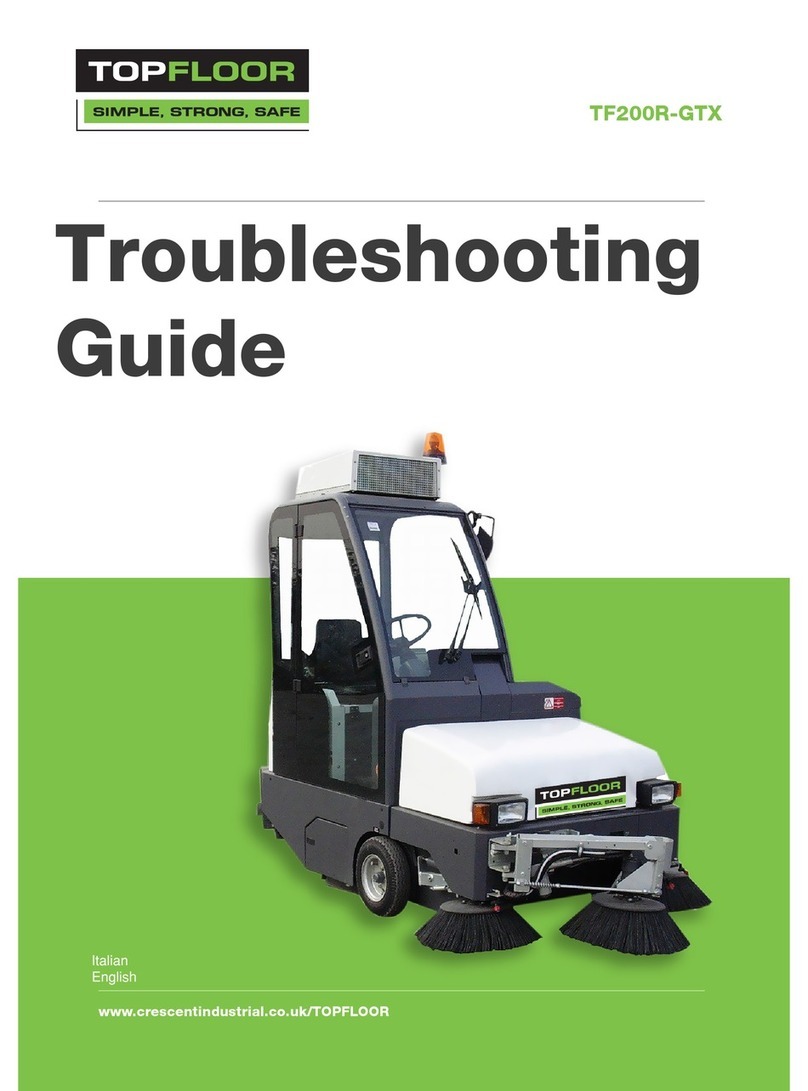
Topfloor
Topfloor TF200R-GTX User manual
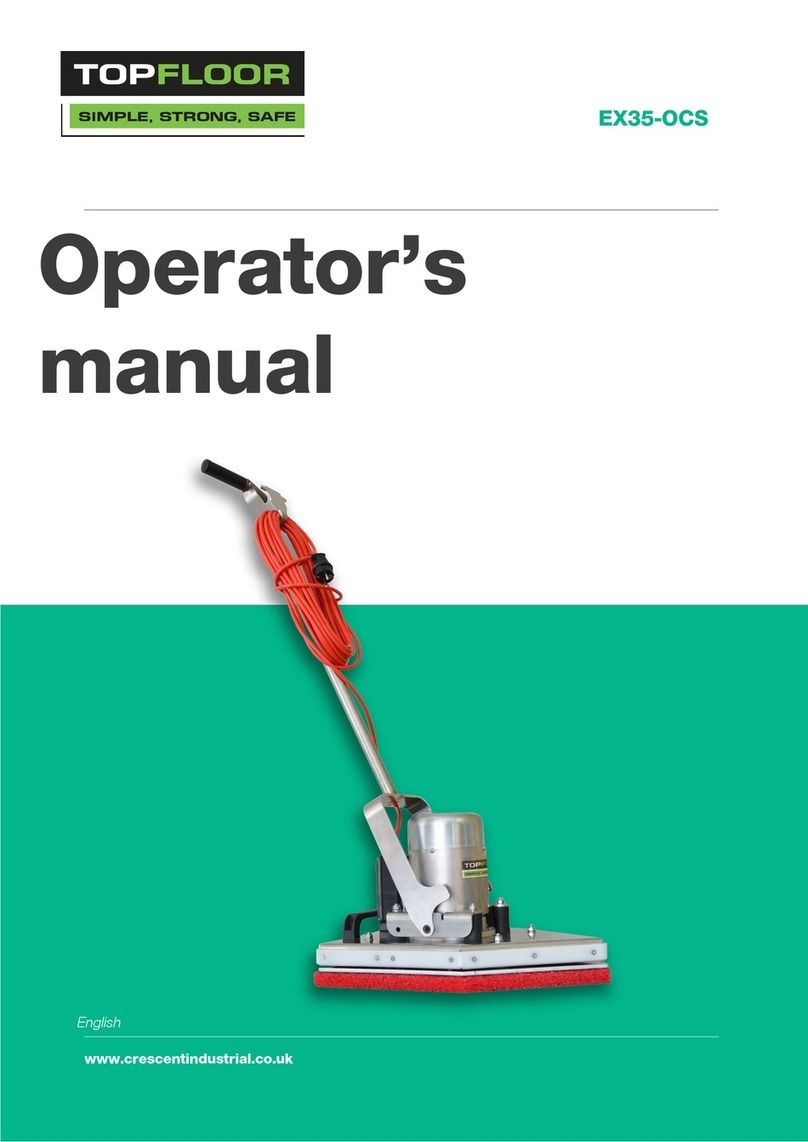
Topfloor
Topfloor EX35-OCS User manual

Topfloor
Topfloor EX35-OCS Instruction manual
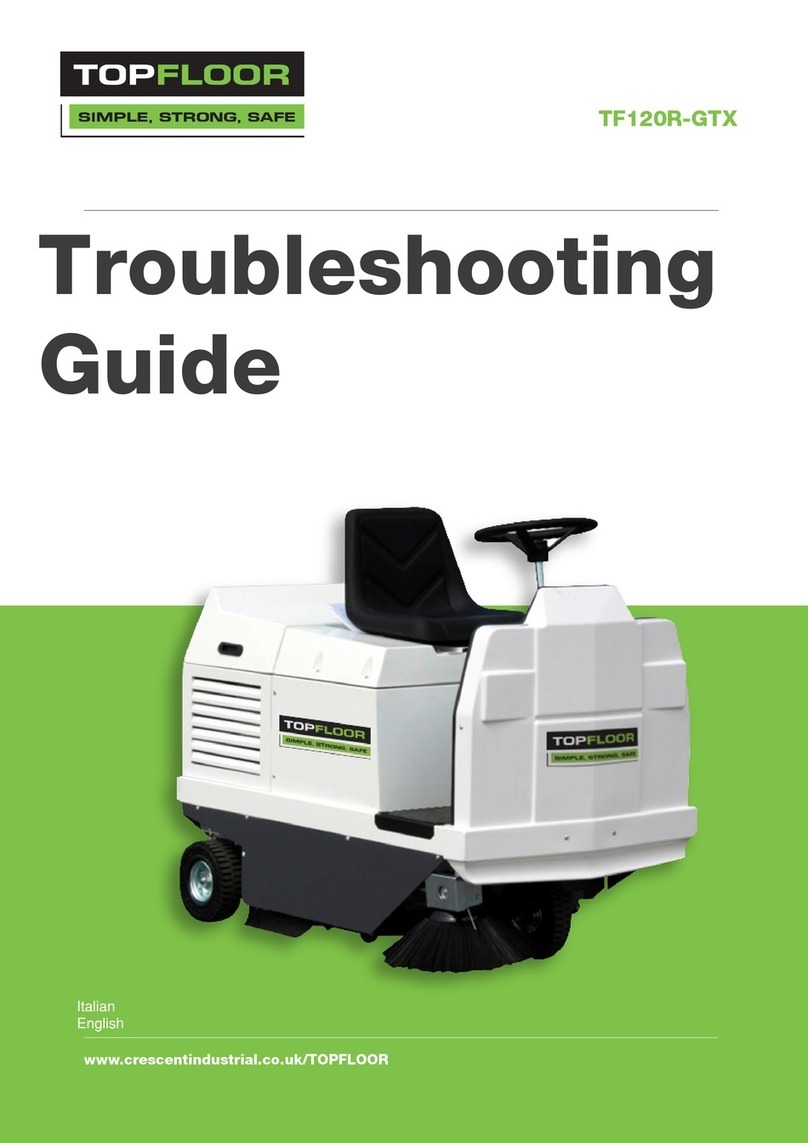
Topfloor
Topfloor TF120R-GTX User manual
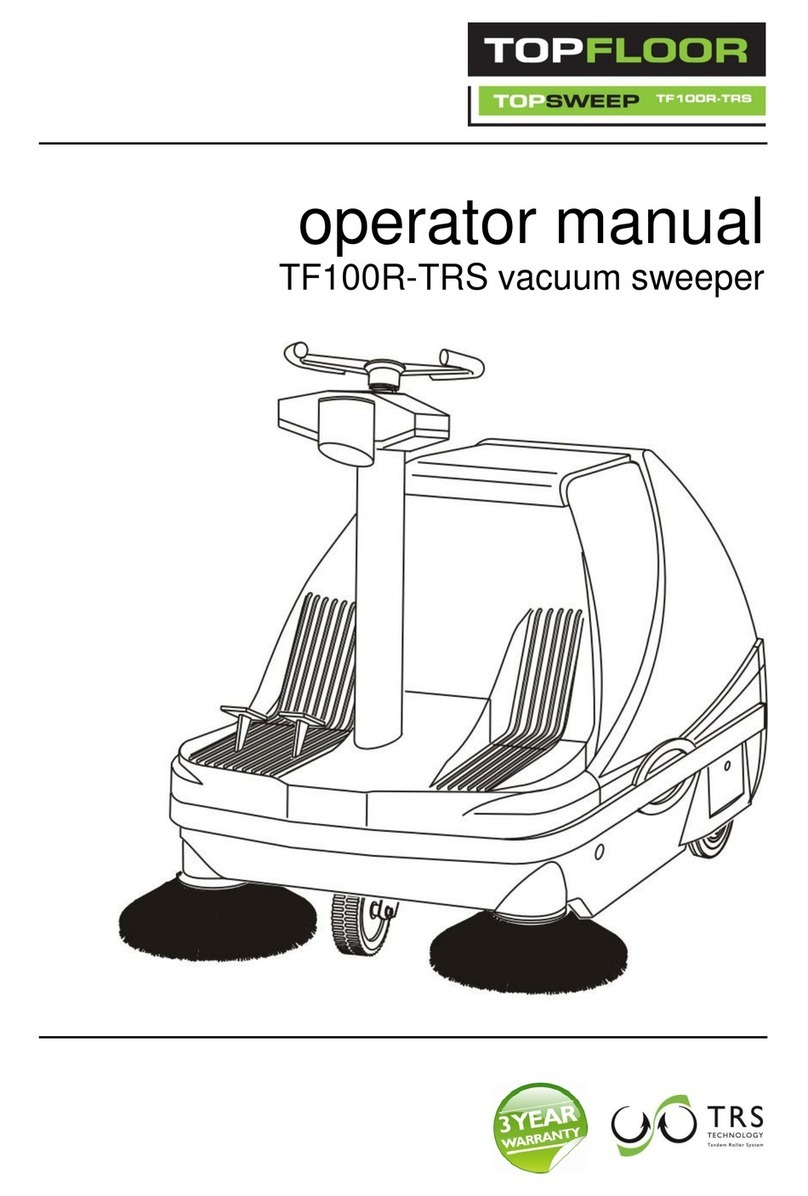
Topfloor
Topfloor TF100R-TRS User manual
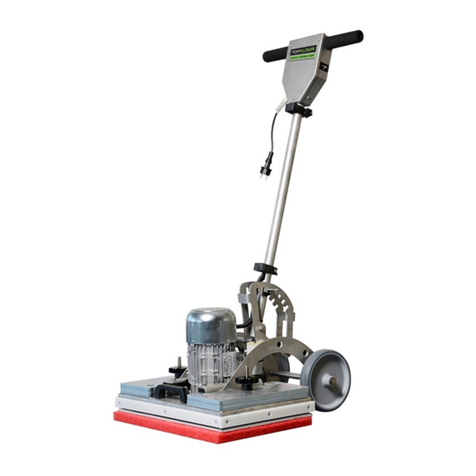
Topfloor
Topfloor EX55-OCS Instruction manual

Topfloor
Topfloor TF200R-GTX User manual

Topfloor
Topfloor EX55-OCS User manual
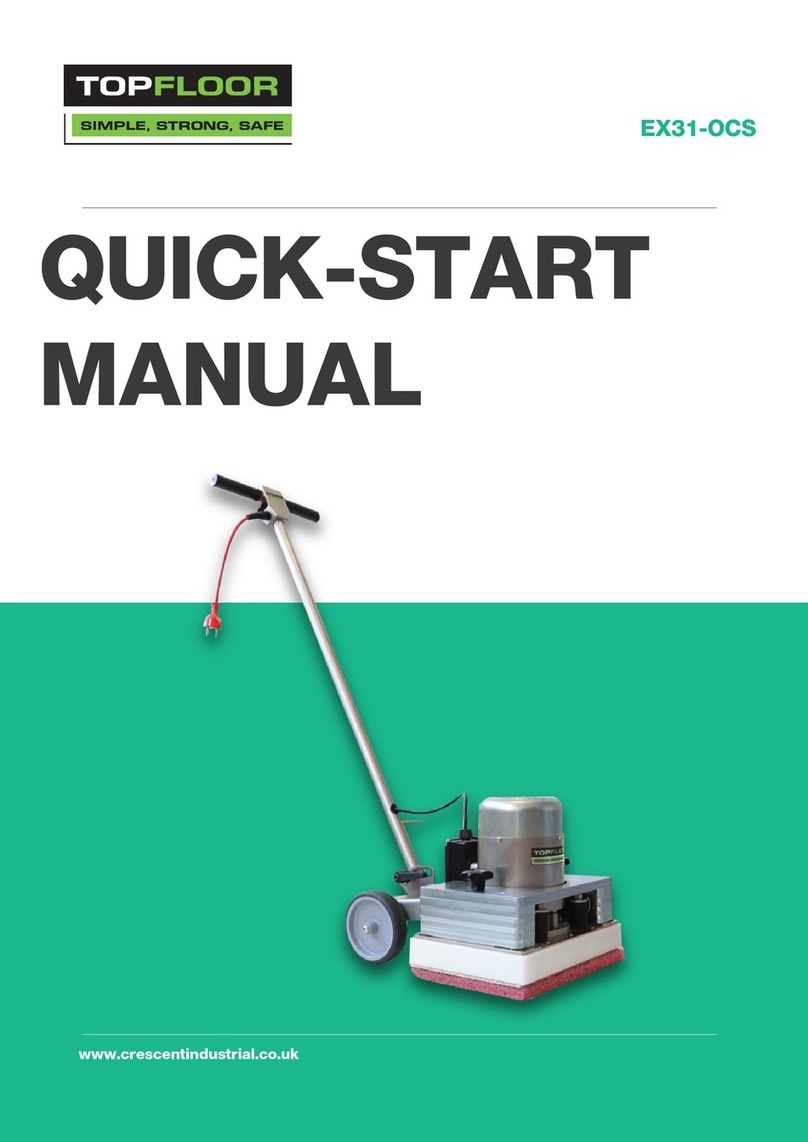
Topfloor
Topfloor EX31-OCS Instruction manual
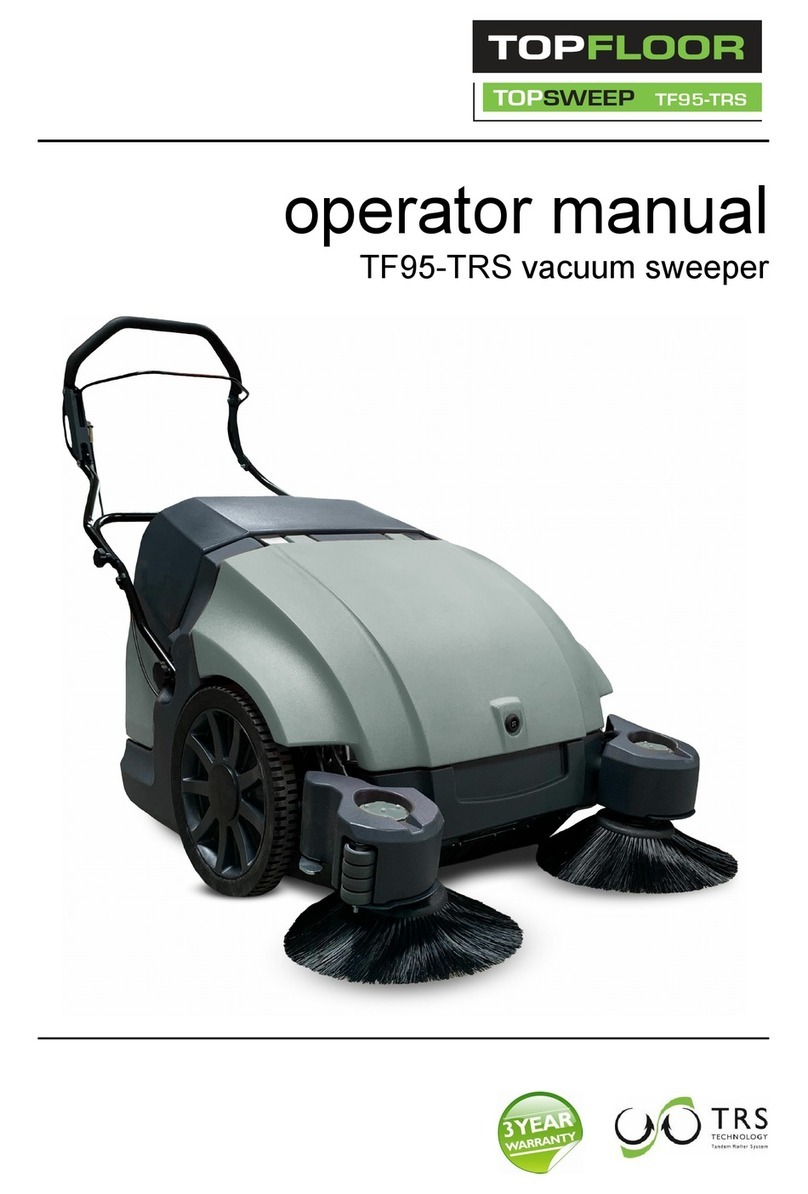
Topfloor
Topfloor TOPSWEEP TF95-TRS User manual
